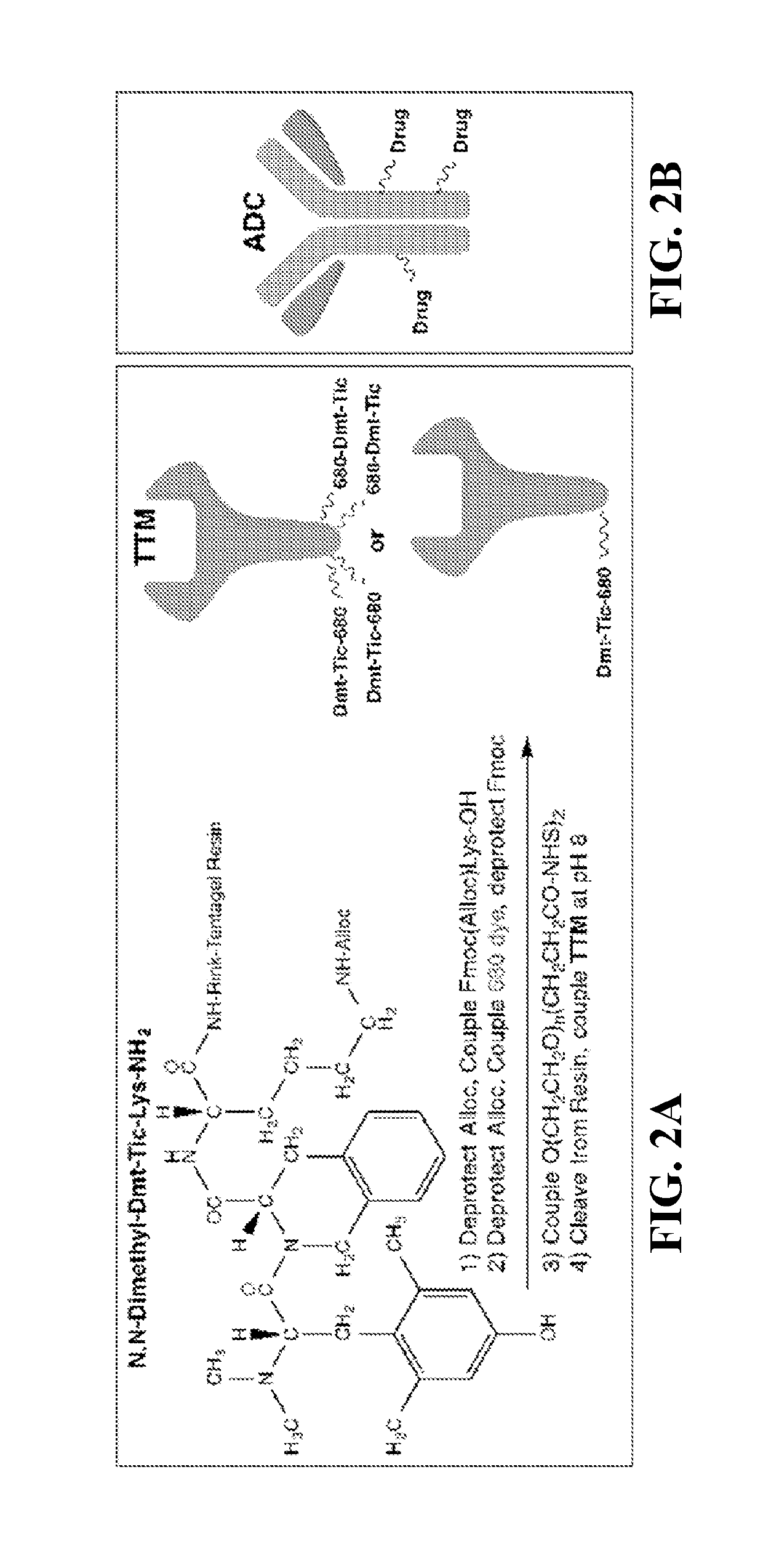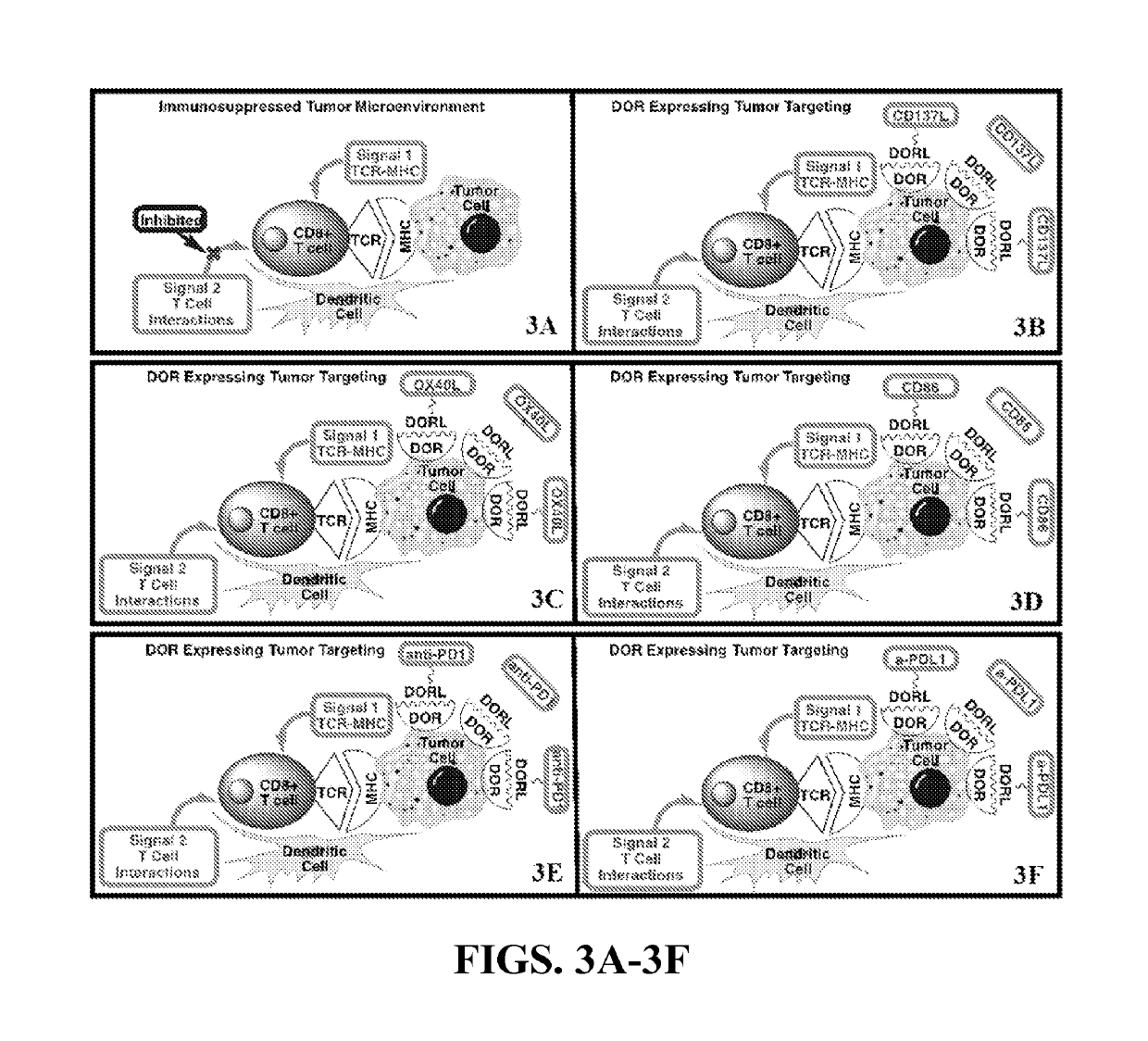Conjugates for immunotherapy
a technology of conjugates and immunotherapy, applied in the field of conjugates for immunotherapy, can solve the problems of inflammatory damage of normal tissues, severe and life-threatening immune-related adverse events seen in patients, etc., and achieve the effects of reducing adverse immune-related events, modulating and/or controlling immune signals directed to target cells, and enhancing immune respons
- Summary
- Abstract
- Description
- Claims
- Application Information
AI Technical Summary
Benefits of technology
Problems solved by technology
Method used
Image
Examples
example 1
gonist Conjugated to Immune Effectors to Treat Breast Cancer
[0087]An embodiment of the current invention provides an LHRH antagonist, Cetrorelix, conjugated to human recombinant CD86, 41BBL, or OX40L ectodomain as a therapeutic agent for treatment of breast cancer. The FDA-approved LHRH antagonist, Cetrorelix, is connected via a trifunctional linker to VivoTag 680 and to an amine reactive site for coupling with primary amines on the surface of the commercially available human recombinant CD86, 41BBL, or OX40L ectodomain. The binding and the timing of uptake of the Cetrorelix conjugated to VivoTag 680 with and without the immune effector conjugates with LHRH positive (MDA-MB-231 and HCC1806) and LHRH-R siRNA knocked down MB-231 cells using in vitro fluorescence microscopy studies verifies LHRH binding affinity and specificity. Those same human cell lines can be used for in vitro immune activation assays. Untreated and treated groups (Cetrorelix, each cetrorelix construct alone, CD86+...
example 2
Immunotherapy by Targeting Immune Effectors to Ovarian Cancers Expressing LHRH
[0093]This embodiment of the invention provides a highly innovative strategy to deliver immunotherapy to subjects with ovarian cancer. This embodiment can dramatically enhance the efficacy of immunotherapy by delivering immune effectors to ovarian cancer cells in a highly efficient and targeted manner using the LHRH targeting approach. Due to high expression of LHRH in ovarian cancers, OVCA is an excellent model to explore this highly innovative and novel approach to targeted solid tumor immunotherapy.
[0094]Other cancers that can also be targeted using the LHRH ligand immune targeting approach include prostate, breast, endometrial, and pancreatic cancers. This approach is likely to reduce or eliminate the dose-limiting adverse immune responses seen with systemic immunotherapy approaches and make it safe to use combinations of strong immune stimulators that cannot currently be used safely in standard of car...
example 3
Immunotherapy by Targeting Immune Effectors to Cancers Expressing Delta Opioid Receptor (DOR)
[0097]This embodiment of the current invention provides innovative strategies for prevention and treatment of early and / or localized lung cancer. This embodiment provides an immunotherapy by specifically delivering immune effectors to lung tumors that express the delta opioid receptor (DOR) using the well-known DOR ligand targeting approach. A majority of non-small cell lung cancer cancers (NSCLC) express greater DOR than normal lung tissues. As such, this embodiment focuses on the delivery of immune effectors to NSCLC. This approach will yield therapies that can safely and effectively enhance the immune response to the lung cancer and potentially lead to complete clinical responses.
[0098]There are several targeting ligands from which to choose, but the delta opioid receptor (DOR) ligand antagonist Dmt-Tic is the subject of this Example, as the antagonist of a cell surface receptor specific ...
PUM
| Property | Measurement | Unit |
|---|---|---|
| molecular weight | aaaaa | aaaaa |
| molecular weight | aaaaa | aaaaa |
| molecular weight | aaaaa | aaaaa |
Abstract
Description
Claims
Application Information
 Login to View More
Login to View More - R&D
- Intellectual Property
- Life Sciences
- Materials
- Tech Scout
- Unparalleled Data Quality
- Higher Quality Content
- 60% Fewer Hallucinations
Browse by: Latest US Patents, China's latest patents, Technical Efficacy Thesaurus, Application Domain, Technology Topic, Popular Technical Reports.
© 2025 PatSnap. All rights reserved.Legal|Privacy policy|Modern Slavery Act Transparency Statement|Sitemap|About US| Contact US: help@patsnap.com



